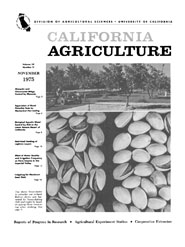


University of California
California Agriculture
|
|||
|
|||

Cover:
Top shows boom-shaker in pistachio nut orchard. Bottom shows nuts harvested
by boom-shaking (left) and (right) by handstripping those remaining after shaking.
November 1975
Volume 29, Number 11 News and opinion |
|||
|
University of California, 1301 S. 46th St., Bldg. 478 Richmond, CA
|